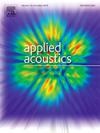Topological rainbow trapping and broadband piezoelectric energy harvesting of acoustic waves in gradient phononic crystals with coupled interfaces
IF 3.4
2区 物理与天体物理
Q1 ACOUSTICS
引用次数: 0
Abstract
Topological phononic crystals (PCs) offer an innovative method for manipulating acoustic or elastic waves. In this study, we introduce the gradient PC structures with coupled interfaces, specifically designed to achieve topological rainbow trapping and broadband acoustic energy harvesting. By leveraging the geometric symmetry of PC unit cells, we merge two PCs with distinct topological phases to create coupled topological interfaces. Gradient modulation of structural parameters along the coupled interfaces induces rainbow trapping, where acoustic waves are spatially separated by frequency. The numerical and experimental results indicate that the acoustic waves of various frequencies are halted and magnified at distinct locations within the coupled interfaces. Compared to the bare harvester, the topological PC energy harvester markedly increases output power across a range of excitation frequencies, with a maximum amplification ratio of 91 observed in experiments. Furthermore, the topological rainbow trapping is robust against random structural disorders. The coupled interfaces exhibit broadband and multimodal capabilities, holding potential for various applications including selective filtering and enhanced sensing.

求助全文
约1分钟内获得全文
求助全文
来源期刊

Applied Acoustics
物理-声学
CiteScore
7.40
自引率
11.80%
发文量
618
审稿时长
7.5 months
期刊介绍:
Since its launch in 1968, Applied Acoustics has been publishing high quality research papers providing state-of-the-art coverage of research findings for engineers and scientists involved in applications of acoustics in the widest sense.
Applied Acoustics looks not only at recent developments in the understanding of acoustics but also at ways of exploiting that understanding. The Journal aims to encourage the exchange of practical experience through publication and in so doing creates a fund of technological information that can be used for solving related problems. The presentation of information in graphical or tabular form is especially encouraged. If a report of a mathematical development is a necessary part of a paper it is important to ensure that it is there only as an integral part of a practical solution to a problem and is supported by data. Applied Acoustics encourages the exchange of practical experience in the following ways: • Complete Papers • Short Technical Notes • Review Articles; and thereby provides a wealth of technological information that can be used to solve related problems.
Manuscripts that address all fields of applications of acoustics ranging from medicine and NDT to the environment and buildings are welcome.
 求助内容:
求助内容: 应助结果提醒方式:
应助结果提醒方式:


